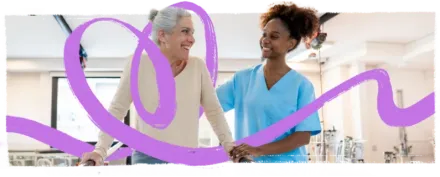
Whether a person has lasting disability after a stroke—and how much—depends on the size of the brain injury and the specific parts of the brain that are damaged. Rehabilitation is vital to stroke recovery. Stroke is the number one cause of serious adult disability in the U.S. and worldwide, but with treatment and rehabilitation, most people with stroke are able to recover some function. Ongoing research in this area has supported the development of several potential approaches and therapies to help rehabilitate people after stroke. Rehabilitation therapy often includes relearning or overcoming the loss of abilities like walking, processing language, and thinking clearly.
Source: American Stroke Association
Achieving the Best Long-Term Outcome
Although the brain can rewire its circuits after a stroke, improving function over months or years, rehabilitation can make a huge difference in helping survivors achieve the best long-term outcome.
Therapy Often Starts Within 48 hours
Rehabilitation therapy usually first takes place in the hospital within 48 hours of a stroke. It often starts with exercises to help overcome any paralysis or weakness. Recovering the ability to do basic activities of daily living is the first stage in the return to independence after having a stroke.
Professionals Who Specialize in Post-Stroke Rehabilitation
- Physicians
- Rehabilitation nurses
- Physical therapists
- Occupational therapists
- Therapeutic recreation specialists
- Speech-language pathologists
- Vocational therapists
- Social workers
- Psychologists
Rehabilitation Facilities
Many stroke survivors return home after discharge from the hospital, but some move into a medical facility or other rehabilitation program. The options are:
| Facility | Description |
|---|---|
| Inpatient rehabilitation | Therapy and rehabilitation care received while at the hospital post-stroke |
| Outpatient units | Therapy and rehabilitation care received outside of the hospital, at a clinic or facility |
| Skilled nursing facilities | Therapy and rehabilitation care provided by trained registered nurses in a medical setting |
| Home-based rehabilitation programs | Therapy and rehabilitation care administered by a trained provider in your home |
Devices to Support Stroke Recovery
The U.S. Food and Drug Administration (FDA) has approved several devices to support rehabilitation and recovery after stroke. For example, the Neurolutions Upper Extremity Rehabilitation System is used to increase range of motion and grasp in people age 18 and older with upper arm disability who are undergoing stroke rehabilitation. The brain-computer interface uses non-invasive electrodes to record brain activity. The electrode reading is then analyzed to determine the intended muscle movement, and a signal is sent to a wireless electronic hand brace, which in turn moves the person's hand.
The MicroTransponder Vivistim Paired VNS System electronically stimulates the vagus nerve, which runs from the brain down to the abdomen, to improve an individual's ability to move their arms and hands. The device is approved for use alongside stroke rehabilitation in people with moderate to severe impairments in their upper limbs and motor defects in their extremities caused by ischemic stroke. As technologies evolve, NINDS-funded researchers are exploring ways to leverage advancements in biologics to support people who have had a stroke.
Stroke Rehabilitation Projects
Another area of research focuses on using rehabilitation to stimulate the brain to rewire itself and compensate for functions lost as a result of stroke. NIH has funded more than 300 research projects involving stroke rehabilitation since 2012. NINDS and other NIH components conduct research on stroke rehabilitation and fund research at major institutions and universities. These are just a few examples:
- The diagnosis and treatment of stroke-related swallowing problems (dysphagia) (through the National Institute on Deafness and Other Communication Disorders [NIDCD])
- Developing new technology for stroke treatment and rehabilitation (through the National Institute of Biomedical Imaging and Bioengineering [NIBIB], collaborating with NINDS and the Eunice Kennedy Shriver National Institute of Child Health and Human Development [NICHD])
- Restoration of vision and rehabilitation (through the National Eye Institute [NEI])
Advancing Rehabilitation Through Technology
NIH is at the forefront of research advancing rehabilitation through technology, including:
Telerehabilitation
A home-based telehealth system designed to improve motor recovery and patient education after stroke. This Phase 2 trial found that intensive home-based daily upper extremity (UE) motor telerehabilitation significantly improved UE function in post-stroke patients and was not inferior to dose-matched therapy delivered in-clinic.
Transcranial Direct Current Stimulation for Post-stroke Motor Recovery
A Phase 2 study (TRANSPORT 2) to find out whether brain stimulation at different dosage levels combined with an efficacy-proven rehabilitation therapy can improve arm function.
Sleep SMART (Sleep for Stroke Management and Recovery Trial)
Determining whether treatment of sleep-disordered breathing with positive airway pressure after acute ischemic stroke or high-risk transient ischemic attack prevents recurrent stroke, and whether treatment of sleep-disordered breathing shortly after acute ischemic stroke improves stroke outcomes at 3 months.
Stroke Recovery Resources
Additional information on recovery may be available from the following organizations and resources:
